about
“Our senses create our experience, and when we are in the mind, we tune out sensations, creating a loop of repeating past experiences. Sound can break you out of that cycle” - Monica
“The sound meditation is an integrated, transpersonal practice whose goal is to enable participants to disengage their undesirable habitual patterns and to empower positive cognitive change. Specific musical instruments played during the meditation allow participants to use sound as a therapeutic tool to disconnect from discursive thinking and delve into a transcendental state.
Most of the instruments I use are overtone-emitting instruments such as gongs, Tibetan singing bowls, bells, metallic discs, etc. These instruments have been used in meditation and sound healing for centuries in many cultures and continue to be used.
What are overtones? Sound emitted by musical instruments, the voice, or any other source is very complex and can be thought of as an infinite sum of waves of different frequencies. The pitch, or tone, that we hear and identify has various components. These components are the fundamental frequency and the overtones, or harmonics, and sometimes called harmonic overtones, which are the natural parts of that pitch. The relative strength or weakness level of these overtones determines the tone color, or timbre, of the pitch allowing us to distinguish the sound of a note played on a flute from the sound of the same register note played on a violin, or distinguishing one person’s voice from an other. The fundamental frequency is much louder than the harmonics which is why we hear it as a single pitch. These overtones start to become clearly audible to our ears when we hear the sound emitted by metallic instruments such as gongs, Tibetan bowls and other overtone-emitting instruments.
The harmonic overtone series is a serious subject of study for not only musicians but also for mathematicians and physicists who are specialized in acoustics which is the study of sound and sound waves. All the notes of scales, modes, and harmonic systems in the world came out of the harmonic series. This series is an inexhaustible set of probabilities, and a blueprint for sound production.
Westerners often note that some of these overtones from these instruments sound quite foreign and out of tune to them. Here’s why: In the 16th century, the West created a tuning system that we still follow called the equal temperament, which essentially divided the musical octave into 12 equidistant half steps (the half step is the distance between a black and the adjacent white key on the piano). Most ancient musical cultures in the world did not adopt this system that we’ve become so used to in the West. So what’s unique about the sound meditation is that participants are immersed in the sounds of nature’s true harmony.” -Alexandre Tannous : sound meditation.com
“Sound therapy brings awareness to the inner processes of the mind: the habitual patterns, the good and bad discursive thinking, the judgment, the filters through which we experience the inner and the outer worlds and realities”
Alexandre Tannous
Instruments frequently used in sound therapy:
Singing bowls
Gongs
chimes
Tuning forks
Bells
Sansula
Monolina
Rainstick
Shruti Box
Frame Drum



